





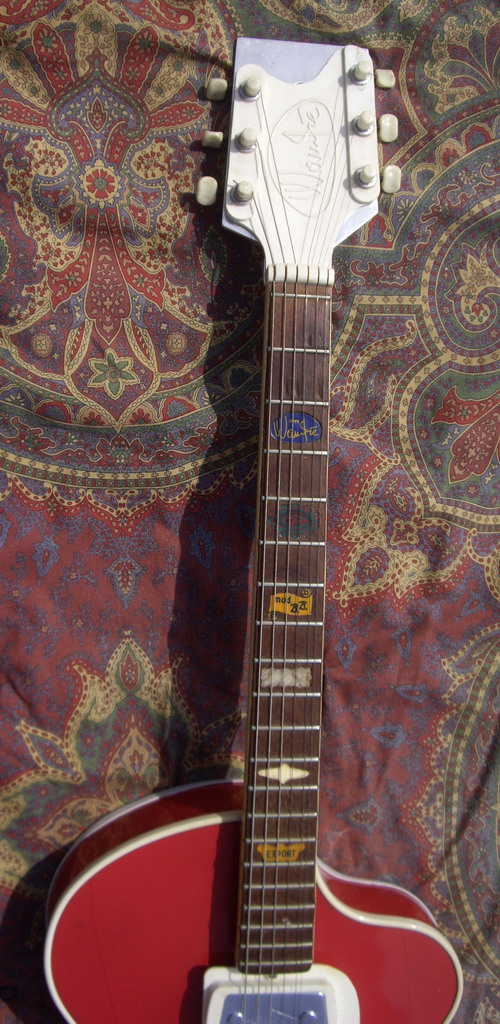






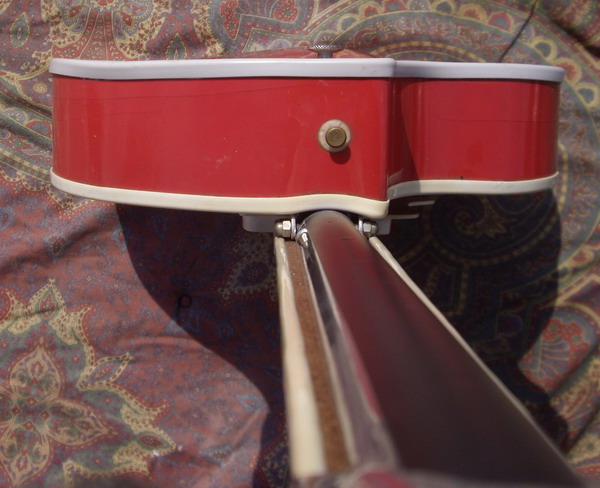




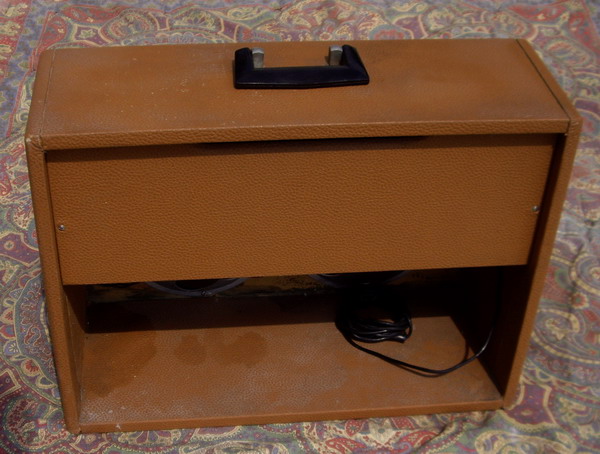

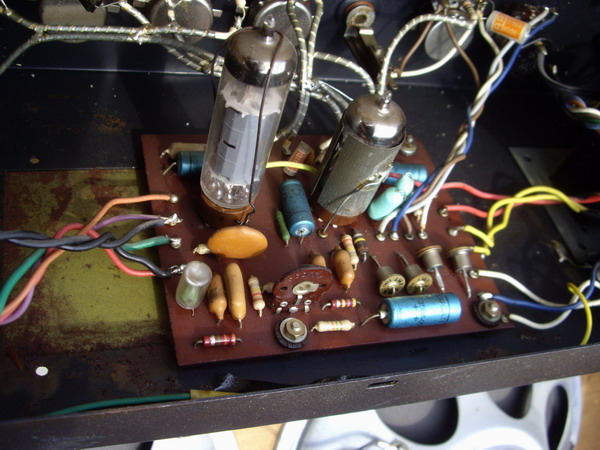


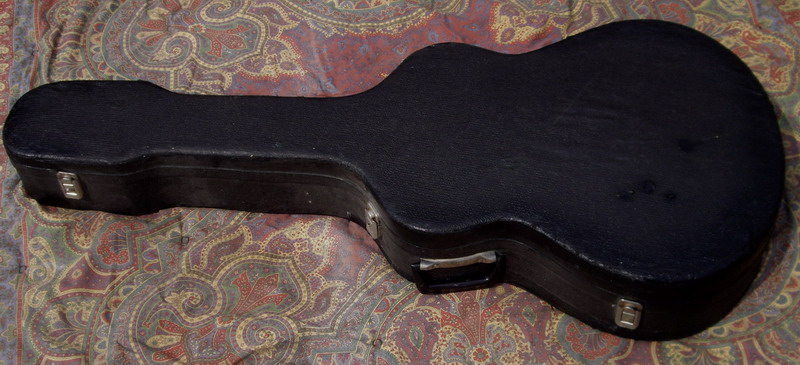

WANDRE FRAMEZ B.B. MODEL, Red Color, Excellent
and original conditions + DAVOLI AMP
From My Collection
codeVA903
Instruments produced in Italy
during the mid 1950s through to the late 196Os. Distributed in the U.S.
by Don Noble and Company, and in the U.K. by Jennings Musical Industries,
Ltd (JMI).Wandre guitars help define where art design and guitar
production cross. Designed by ltalian motorcycle and guitar appreciator,
Wandre' Pelotti (1916‑1981) was an artist and sculptor from Milan.
Wandre' instruments are oddly shaped thinline hollow body electric or
solid body electric guitars with either Framez or Davoli pickups.Wandre'guitars
were personally produced by Pelotti from 1956/1957 to 1960. Between 1960
and 1963, the designs were produced by Framez in Milan, Italy; then by
Davoli from 1963 to 1965. Pelotti supervised construction from 1966 to
1969 in his own factory.Wandre's instruments may bear a number of
different brandnarnes, but the Wandre'Iogo will appear somewhere. Other
brandnames include Davolí, Framez, JML Noble, Avalon, Avanti I, Krundaal,
and possibly others.These solid body (and some hollow body) quitars
featured aluminum necks (called “Duraluminum") with wood fingerboords,
and plastic coverings on the body. Finishes include multi‑color or
sparkle, as well as linoleum and fibergloss body parts. The B.B. model
was named in honor of actress Brigitte Bardot. The futuristic body
designs of the Rock Oval, Spazial, and Swedenbass may have some visual
appeal, but the level of playing quality isn't as high as the coolness
factor may indicate.
http://www.youtube.com/watch?v=QOeDON6PAa8
Instruments
produced in Italy during the mid 1950s through to the late 196Os.
Distributed in the U.S. by Don Noble and Company, and in the U.K. by
Jennings Musical Industries, Ltd (JMI).Wandre
guitars help define where art design and guitar production cross.
Designed by ltalian motorcycle and guitar appreciator, Wandre' Pelotti
(1916‑1981) was an artist and sculptor from Milan. Wandre' instruments
are oddly shaped thinline hollow body electric or solid body electric
guitars with either Framez or Davoli pickups.Wandre'guitars were
personally produced by Pelotti from 1956/1957 to 1960. Between 1960 and
1963, the designs were produced by Framez in Milan, Italy; then by
Davoli from 1963 to 1965. Pelotti supervised construction from 1966 to
1969 in his own factory.Wandre's instruments may bear a number of
different brandnarnes, but the Wandre'Iogo will appear somewhere. Other
brandnames include Davolí, Framez, JML Noble, Avalon, Avanti I, Krundaal,
and possibly others.These solid body (and some hollow body) quitars
featured aluminum necks (called “Duraluminum") with wood fingerboords,
and plastic coverings on the body. Finishes include multi‑color or
sparkle, as well as linoleum and fibergloss body parts. The B.B. model
was named in honor of actress Brigitte Bardot. The futuristic body
designs of the Rock Oval, Spazial, and Swedenbass may have some visual
appeal, but the level of playing quality isn't as high as the coolness
factor may indicate.

Antony Wandre Pioli, who describes
himself as an "Artist of Life," was born in Cavriago in the central
northern Italian province of Reggio Emilia in 1926, the son of
violin maker Roberto Pioli. During World War II, he served in the
underground resistance. Following the war he made a living by
supervising masonry projects.In the mid '50s Pioli became interested
in new technologies to build guitars.He originally hooked with
Italian guitar manufacturer Framez which was run by the Fratelli
Meazzi (the Meazzi Brothers - which begs the question, are they
related to Click & Clack [Tom & Ray]?) with pickups made by
Abel Naldi. Wandre produced 57 to 61 per Meazzi’s records.Starting
in 1959 he moved his production to Cavriago and hooked up with
electronics expert Athos Davoli. Davoli’s company at the time was
part of a conglomerate known as Radio Elettromeccanica Krundaal,
located in Parma, Italy. The two worked on developing the
electronics that eventually appeared in Wandré guitars. By '62 or
'63 Wandré Pioli's guitar ideas had pretty much come together, and
the primary shapes for which he's best known had been
introduced.Pioli's guitars were musical sculptures. The pickups made
by the Athos Davoli company were large, trapezoid-shaped pickups
with stamped metal covers that said “Davoli/Made In Italy.” The
Davoli pickup cover imprint was often the only identification found
on Wandré guitars, contributing to the misinformation that they are
“Davoli” guitars.As a sculptor, Pioli fabricated his guitars using a
bakelite top with a wood back and sides. As his production was very
limited, Wandre guitars are very rare and according to "the
illustrated encyclopedia of electric guitars" the are "the most
eccentric European guitars of any period in guitar history".Wandré
was attracted early on to aluminum and it’s structural material. He
was a motorcycle enthusiast and restored motorcycles. He was often
seen riding the Italian countryside. His interest in motorcycles was
reflected in the design and workmanship of his guitar vibrato
system. The same could be said of motorcylce enthusiast Paul Bigsby,
who in the United States invented his famous version of the guitar
vibrato made by using a motorcycle spring. However on some of
Wandre’s vibrato was either a triangular or diamond-shaped affair
was attached to the aluminum core and faced outward with a cast
metal “W”… it looked very much like a motorcycle medallion of the
day.A common occurrence in many guitars of this era was neck warpage.
Wandre solved that with an aluminum neck that featured and
adjustment that allows for placing the neck at a suitable angle for
your playing style - maybe 6 degrees each way parallel of the top.
It also has a neck-through-tailpiece design and the headstock is
also wood framed with aluminunum.The intonation and string height
adjustments are made with an overhead suspension type looking like
an upside-down tune-o-matic which you can rest your palm on it
smoothly. As were many guitars of the day, the neck is very narrow
but kind of like half a baseball bat. The necks were straight as an
arrow, .006 of an inch off over its length. Many of his guitars
featured a neat pushbutton pickup selector switch system that looks
like the old Chrysler automatic transmission pushbuttons of the
60's. He sold his guitars under the names - Jennings UK, noble USA,
Dallas UK, wander ITALY, Krandall, Avalon, Orpheum - Krandall may
have been the parent company of the davoli pickup company.Wandre
guitars were exported throughout Europe and the Americas.
Concentrations of specimens can be seen in the Netherlands and
Argentina. In England and was released by Dallas in the U.S. with
Don E. First with Maurice Noble Lipsky and his trademark Orpheum,
later. In France, the main distributor was Doris.The collaboration
with Davoli lasted until 1970 when Pioli sold his guitar factory to
start a leather clothing business. Wandre guitars production shows
around 70,000 instruments being produced and sold around the world.
Pioli passed away in 2004.

The most notable player of Wandres is Buddy
Miller. Buddy tells a story about buying his first Wandre from a
pawnshop for $50. There are some Wandres selling now for $40,000.
Emmylou Harris & Buddy Miller -
Wide River To Cross - Miracle On Music Row - 4th Annual
http://www.youtube.com/watch?v=-hthAJTrozM
http://www.fetishguitars.com/wandre/wandre-bb-19571963/
https://www.youtube.com/watch?v=xyRFpHMDSjM
https://www.youtube.com/watch?v=04jz8N3_1v8
https://www.youtube.com/watch?v=b-KVIOa9-n8
https://www.youtube.com/watch?v=a38J_NoHsrI
A Cavriago è nato nel 1926 Antonio Pioli,
soprannominato "Wandre", che a partire dalla seconda metà degli anni '50
ha ideato una serie di chitarre, bassi e contrabbassi famosi in tutto il
mondo. Reggio nel Web vuole dare spazio alla storia di questo nostro
concittadino che ha avuto un enorme successo internazionale. Antonio
Pioli nasce il 6 giugno 1926 a Cavriago. Fin da bambino risalta la sua
personalità originale e stravagante tanto che il padre lo soprannominerà
simpaticamente "Wandre" che in dialetto significa "Vai indietro".La
passione per la costruzione di chitarre bassi e contrabbassi inizia
intorno alla seconda metà degli anni '50 quando "Wandre" incomincia a
ideare modelli di strumenti estremamente innovativi e all'avanguardia.
Le sue realizzazioni sono un "mix di astrattismo ed eccentricità con
soventi richiami a soggetti vagamente antropomorfi".Il carattere
stravagante di Pioli non si ferma solamente alla costruzione di
chitarre: lo stesso laboratorio in cui lavorava era di forma circolare,
ma anche il passaggio attraverso varie forme d'arte, come negli ultimi
anni la body art, hanno fatto sì che un critico lo definisse "l'ultimo
degli Scapigliati". I modelli prodotti da Wandre sono innumerevoli ma
ciò che risultava più caratteristico della sua produzione era "il manico
in alluminio, sul quale veniva applicata la tastiera di legno" ciò
procurava un vantaggio notevole: una stabilità perfetta nel corso del
tempo.All'inizio della sua attività Pioli si appoggiò all'aiuto
dell'impresa Framez dei fratelli Meazzi di Milano. Durante questo
periodo nacquero chitarre semiacustiche di grande prestigio come la B.B.,
probabilmente dedicata alla famosa attrice, la Waid e la Selene, la
cassa era senza buchi. Ma il top della produzione risultò essere la Rock
Oval, che fu anche nelle mani di Adriano Celentano ai tempi del mitico
rock' n' roll. La Rock Oval e la sua gemella semiacustica Rock and Roll
formavano una coppia veramente eccezionale che ha lasciato stupiti sia
il pubblico che i musicisti.Le produzioni di Wandre non erano solo
commerciate in Italia ma anche all'estero, in particolare in Gran
Bretagna. All'inizio degli anni '60 incominciò la collaborazione con la
casa costruttrice di amplificatori Davoli. Questa collaborazione segnò
un momento fondamentale nella storia degli strumenti prodotti in Italia:
la chitarra subì cambiamenti radicali, in particolari come il battipenna,
gli attaccacorde e soprattutto nel pick-up.Questo periodo diede i natali
al modello Bikini, con amplificatore incorporato, e alla Blue Jeans che
veniva commercializzata insieme all'amplificatore.Parallelamente alla
produzione di chitarre era attiva anche quella di bassi fra i quali si
possono citare lo Sweden bass, minicontrabasso amplificato che aveva il
controllo del volume vicino alla giunzione manico-paletta, il modello
Etrurian, Tigre, Cobra 1 e 2 e il mitico Scarabeo.L'attività artistica
di Antonio Pioli detto Wandre non si concluse mai, ma fu indirizzata
verso altre forme d'arte. I resti di questo periodo dedicato alla
rivisitazione di chitarre e strumenti affini, sono oggetti da
collezione, ricercati da appassionati di tutto il mondo.
Le prime Wandré che mi si presentarono agli occhi erano una Oval
e una Selene su un libro inglese. La visione si trasformò in un un
sogno.L’acquisto fortunato di una Wandré! Quelle cose che si possono
solo sognare in una notte estiva, letteralmente. Qualche settimana
più tardi comprai una BB su iBazar, era listata come Wonfré, la
pagai un milione e mezzo di lire, all’epoca una follia per una
chitarra di cui non si sapeva niente. Iniziò l’ossessione che mi
portò a possedere quasi tutti i modelli. Se oggi dovessi dire quale
delle Wandré vorrei di nuovo con me, e potessi sceglierne una sola,
sarebbe la BB. Stilisticamente è la chitarra che per i miei gusti
sta sull’esatto confine tra innovazione e tradizione. La sagoma del
corpo, le dimensioni della cassa e la forma delle buche sono ancora
oggi attualissime e moderne. Una interpretazione della chitarra da
jazz con una deformazione delle proporzioni che ha radici nobili e
robuste negli esperimenti di Monzino. La forma della chitarra
soggetta a una naturale e sensuale antropomorfizzazione. Brigitte
Bardot, appunto.L’esemplare che trovai, il primo di una serie, era
esattamente nella migliore configurazione elettrica che si possa
avere tra le tante evoluzioni negli anni; con le buche a effe libere
dai controlli, discretamente ed ergonomicamente posti sulla spalla
superiore, una piccola placca rotonda à la Höfner. Con i segnatasti
orizzontali bianchi, più sobri dei successivi intarsi colorati, più
vicini alla tradizione ma impreziositi dal nome perlinato al terzo
tasto. Esagerando, potemmo dire che la livrea nera con binding
bianco è l’unica possibile per una BB. Un magnifico tubino nero
aderente sulle forme di Brigitte Bardot, la musa ispiratrice,
risposta iconoclasta alle teutoniche chitarre in frack ( vedi
Hoyer Herr Im Frack).
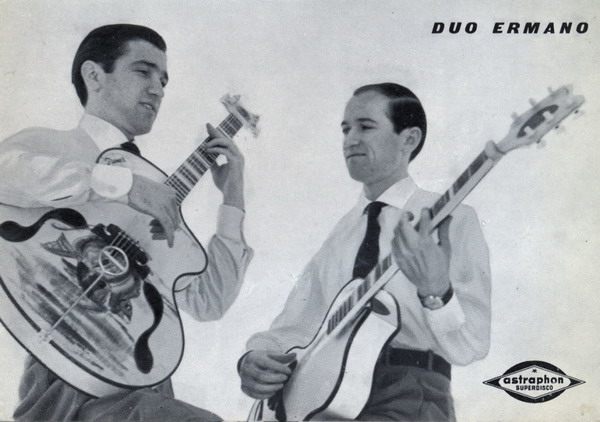

Davoli History:
http://www.wilderdavoli.it/app/index.jsp?IdC=320&nome=La%20nostra%20storia&IdC1=320&tipo=0&css=

-----------------------------------------------------------------------
Quella che segue è una parte della trascrizione della
registrazione video realizzata il 20 febbraio 2004 al Teatro Valle di Roma, in
occasione dell'incontro col Sommo e con Francesco Guccini per la presentazione
del libro di Francesco Guccini "Cittanòva Blues".
Visibile nel sito e link originale:
http://www.vigata.org/bibliografia/guccini.shtml
FG
Ecco, devo chiedere una pagina 46. C'è la nota 11... "bucaioli c'è le paste!"
che è toscano questo, e dice la frase sarebbe "Bucaioli c'è le paste!" Perché
parlando di una chitarra... vabbè, se volete vi leggo la cosa della chitarra poi
vi parlo di "bucaioli c'è le paste".
"... Era, quella chitarra, una cosa vomitevole assai, ideata da intelligenze
sconvolte di locali mentecatti, italiani dico, di un colore rosso mattone scuro
cosparso di dorate paillettes ("Bucaioli c'è le paiet!") che colpite da un
subdolo raggio di riflettore da balera, squittivano lor doratura tutt'attorno,
il che aveva affascinato non poco te, l'incolto, ed anche te stesso in parte
mentecatto, suonatore, in quegli scarsamente onorevoli anfratti dati alle
musiche. Erasi, il manico, cosa di metallo, alluminio od altro extraleggero,
fissato alla cassa con grande dado ovviamente avvitabile e svitabile, non a mano
nuda, naturalmente, chè ti sarebbe occorsa la forza muscolare di un Ercole, ma
con opportuna cagnetta la quale, alla chiara bisogna, mai in assoluto recavi
teco. Ben fisso, quindi, ma non nella legittima posizione perpendicolare alla
cassa, che per misteriose sue ragioni il tutto né voleva né sapeva assumere,
ponendosi con un curioso angolo acuto (ottuso, evidentemente, dall'altra parte);
se questo andava a scapito dell'accordatura, e credo che detta chitarra fosse
IMPOSSIBILE accordarla, poteva procurare, tenuta saldamente per la cassa
squassando bellamente il manico su e giù con la mano stanca, un curioso effetto
maniglia di distorsione ancora da inventare ma che molti, rozzi pari a te,
invidiavano anche, gridando alla sovraumana abilità. Per dire.
E' che forse gli anni '60 erano
arrivati e non ce ne eravamo neanche accorti. In pieno pari in quegli anni, ma
vallo a sapere. Il manico poi era stracolmo di scritte, Framez e/o Framus,
bellamente incastrate in varie guisa qua e là per i tasti, se ben ricordavi,
come intarsi di preziosi e rilucenti Madre Perle orientali, come grondante di
lapis azul e corniole e berilli e crisopazi e balasci, e la cassa, dotata ahimè
d'una sola piastrina d'amplificazione di vigorosa plastica giallina, sembrava un
incrocio fra quella d'una usata chitarra ma acromegalica (era, l'ipofisi malata,
il bubbone della giuntura) e un qualcosa di futuribile però non ancora ben
immaginato, un sogno infrantosi all'alba, essendo che la gigantesca cassa piatta
leggermente bombé di suo non dava suono veruno ma solo, era il tutto, immaginato
per l'estetica, il bello per il bello dico, fa' te.
L'amplificatore erasi un parallelepipedo verdolino, sempre colmo di coriandoli
degli allegri trenini a samba dei carnevali e dei cerchi dei bicchieri delle
bibite, che una a testa, venivano servite a gratis durante i servizi, ma questo
non c'entra. E pensare che avevi sdegnosamente rifiutato, per una misera somma,
una Gibson Les Paul nera che ora varrebbe fortune capitali. Rabbia, a pensarci
ma eravamo fatti così." [applausi]
Ora.la frase "bucaioli c'è le paste!" (toscano) che, devo dire, non si capisce
l'unione tra gli omosessuali, bucaioli, e i dolcetti... poi ho beccato un
bravissimo scrittore toscano, un certo Marchetti che scrive con lo pseudonimo di
Borsacchini... sono difficili da trovare i suoi libri perché sono soltanto in
area Toscana, zona livornese, lucchese eccetera... ma se vi capita, lui ha
scritto il dizionario dei modi toscani... "il dizionario universale di
Borsacchini"... lo giuro! Non riesco a rileggere una sua pagina senza piangere
dal ridere, insomma, quindi ho trovato il suo indirizzo e gli ho scritto. E mi
ha spiegato che "bucaioli c'è le paste!" non sono le paste, i dolci, che si
mangiano. In Toscana è la pasta. Quando si arriva con la terrina della pasta:
"C'è le paste!" e ci aggiungono: "bucaioli..." ed io avevo frainteso perché per
me le paste erano i dolcetti. Invece la pasta al plurale per indicare la dovizia
della pasta servita in tavola, quindi, mi scuso per l'informazione non esatta...
Un'altra informazione non esatta che ho dato anni fa nel primo libro... eeeee...
l'espressione pavanese: "fammi ben la semplice"... è un invito alla
masturbazione, io citavo una canzoncina giovanile e goliardica... "bella vieni
bella, vieni con me in bottega" (e l'errore mio era: io ti farò una semplice
dichiarazion d'amore) ecco perché la metafora non la senti, quindi, non si
capisce perché non sono io che la devo fare a lei, ma è lei che dovrebbe farla a
me [risate e applausi] Ahahahahah... errore tragico. [applausi]
Wandre Guitars - The First Metal Necks?



http://www.playlikeapro.com/buddymiller.htm
and...
wandre
and more:
http://www.fetishguitars.com/wandre/

San Vito di Cadore 1962 - I Gatti - Da sinistra Guccini, in
basso seduto Alfio e penultimo Victor


http://www.anniversarybooks.it/wandre/


































